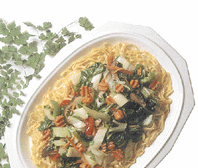
THE WOK is a cooking utensil used in the main for dishes such as vegetable stir fry or meats which are quickly prepared chicken, fish and the tender cuts of beef peppered steak and tenderloin. The food sizes are small stripped or cubed.
The concave surfaces of the wok transfers heat to the food portions quickly. The swiftness of cooking achieved assists in the retention of juices which are sealed in by the cooking method. The speed of preparation also contributes to the retention of colour and texture.
The number of portions that one is able to produce in a short time is also more than that produced in other pans because of the wok's wide surface area. The traditional wok, uncovered, is not usually used for stews of deep fat frying.
Before you use your wok it is essential to wipe the pan inside and out with oiled kitchen paper and heat to a high heat in the oven or on the hob. Remove the wok from the heat, allow it to cool and repeat the process several times to give a good coating this will make it easier to clean and give it a non-stick coating.
USING THE WOK
When cooking with a wok the pan needs to be of a very high temperature before the food is placed in the pan. Once the pan is hot enough and the food is placed inside the wok you need to keep turning the ingredients to ensure that they are kept hot. Using a wok is a good, healthy and quick way to cook vegetables in stir-fried. Cooking for too long will make the ingredients either burn or be saturated with their own juices and become limp and soggy. Vegetables cooked in a wok should be crispy, not wet.
STIR-FRYING
This cooking method originated in China, and remains the more recognised form of Chinese cooking. In China it is called Ch'au which means that a number of ingredients are sliced and cooked in 1-2 tablespoons of fat.
Stir-frying is usually done in stages, this allows foods that have different cooking times to be removed and then returned at a later stage. The dish is then brought together at the end and sauces/spices are added and then the dish is served as a whole.
There are two different types of stir-frying:
Liu is wet frying with slow stirring and more turning of the individual foods. A stock is then added at the end of the cooking time for a coating sauce.
Pao requires foods to be fried at the highest possible heat. This is a quick method lasting for usually only a minute.
CARE AND CLEANING
A wok should be used over moderate flame, as the concave shape helps to retain heat. If this caution is not followed, you might end up, repeatedly, with burnt offerings instead of a delectable dish.
Abrasives should not be used on your Teflon-coated wok. Metal spoons and other utensils should also be avoided. Use rubber-coated ones instead. The wok made of stainless steal should not be cleaned with steelwool, as this wears down the container. Steelwool also leaves a metal residue that, if absorbed by food and taken into the body, can be harmful to your health.
Use non-abrasives or a plastic bristled brush for cleaning the wok.
Woks should be cleaned with simple soap and water. If made of cast iron it should be dried immediately to prevent rusting. The blackening of a wok over time and use is not dirt, as some would believe, it simply is a sign that it has been used well. It is said that the blacker the wok the better the cook.
Compiled by Avia Ustanny, Freelance Writer and
Lovern Hayes, Staff Reporter



























